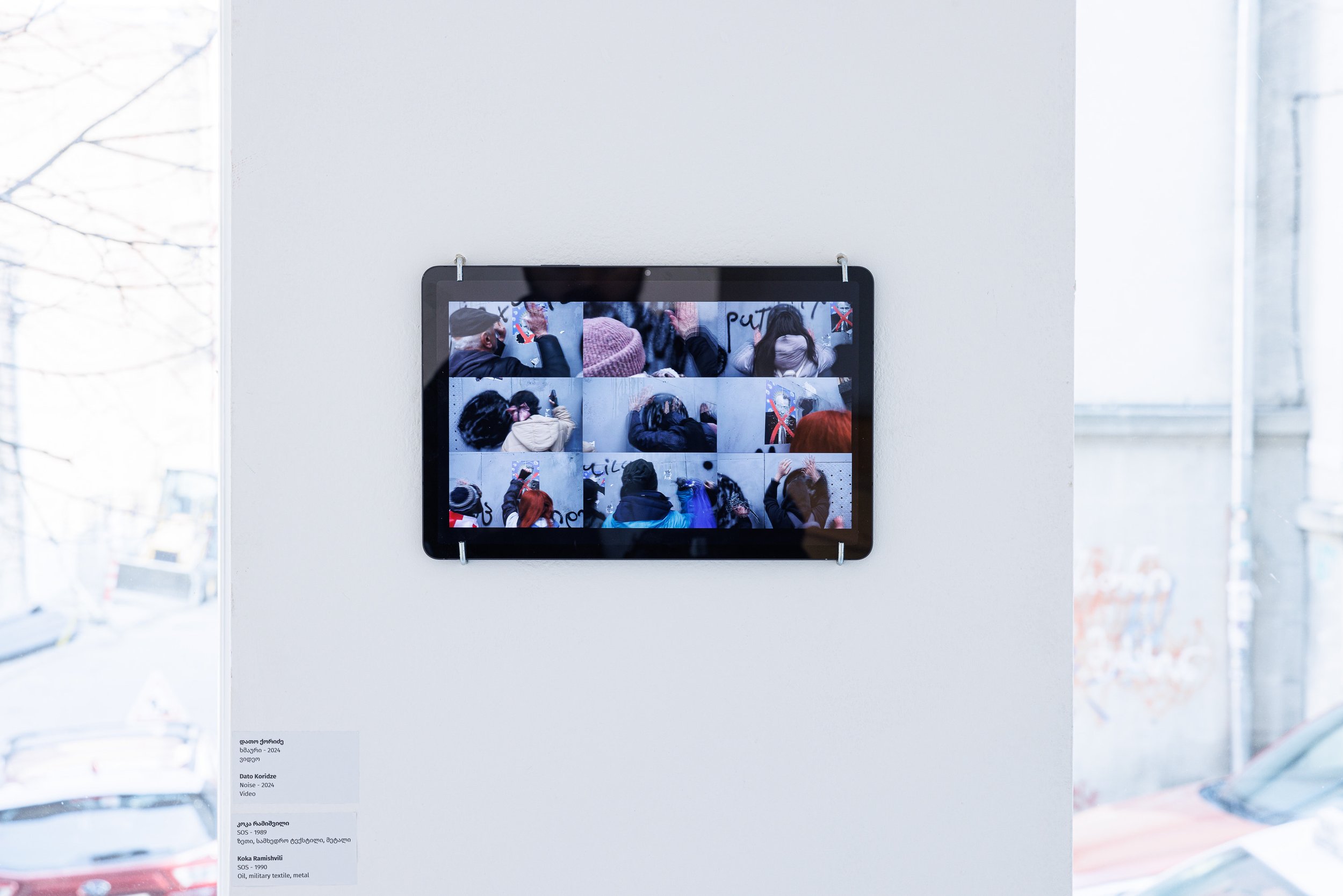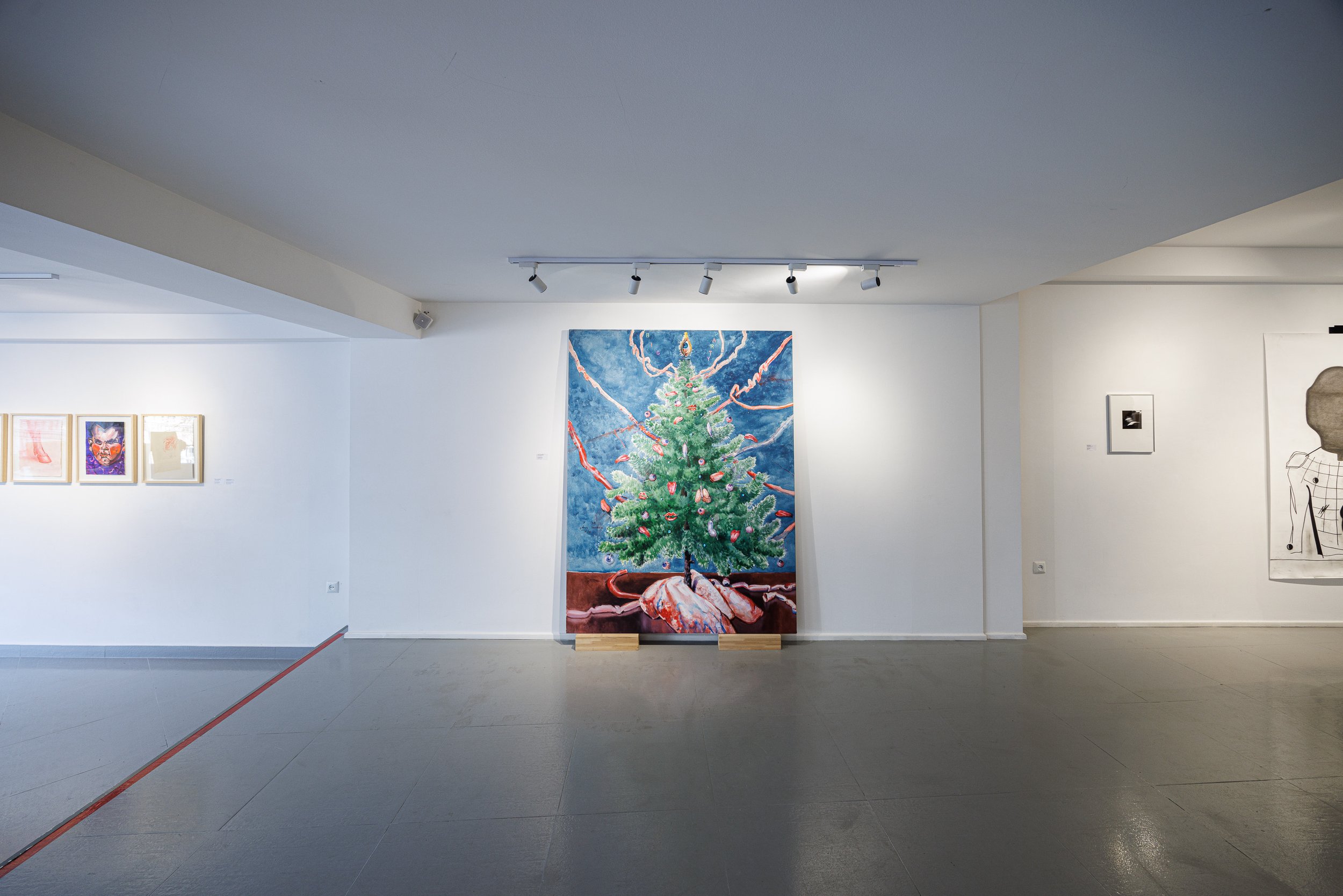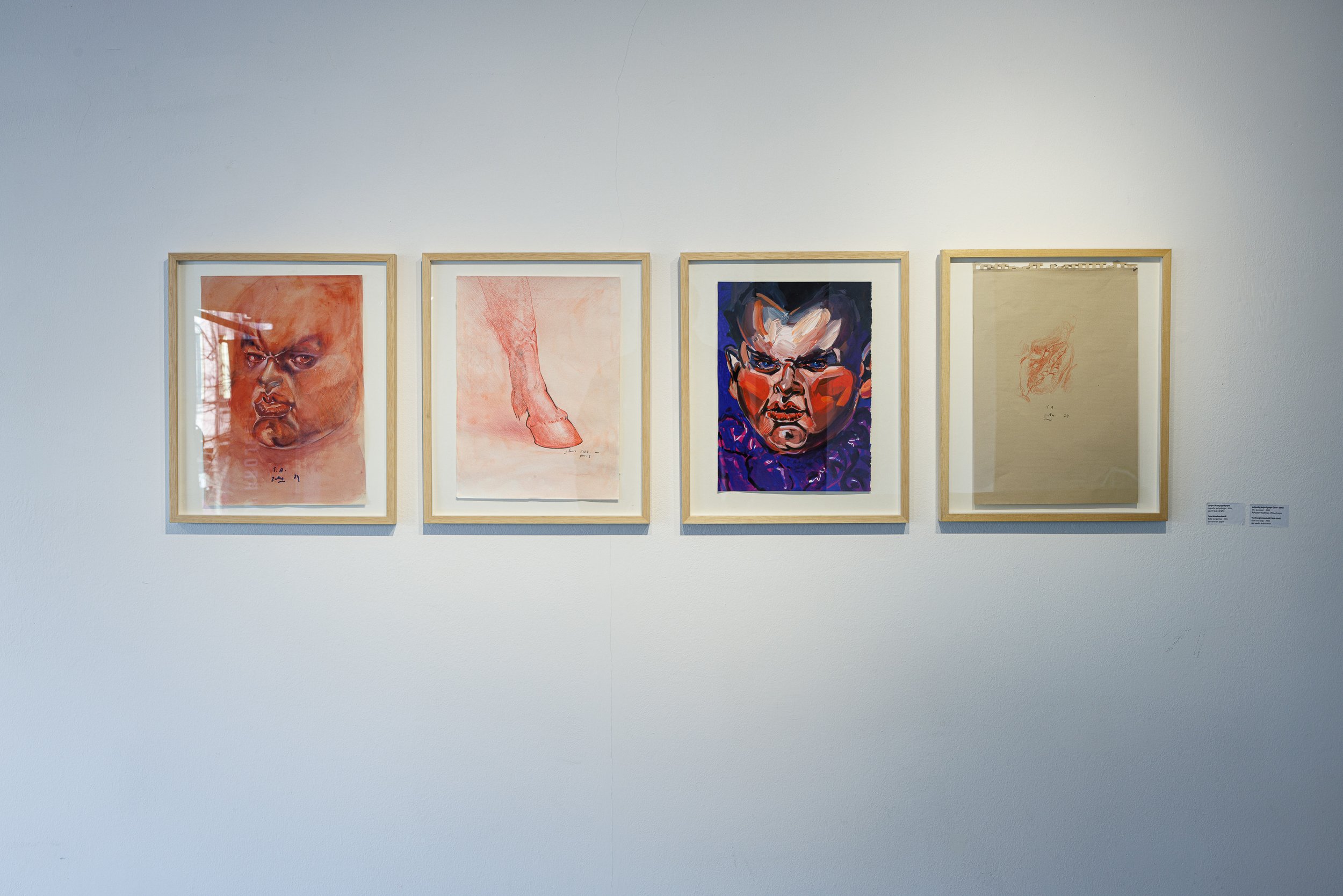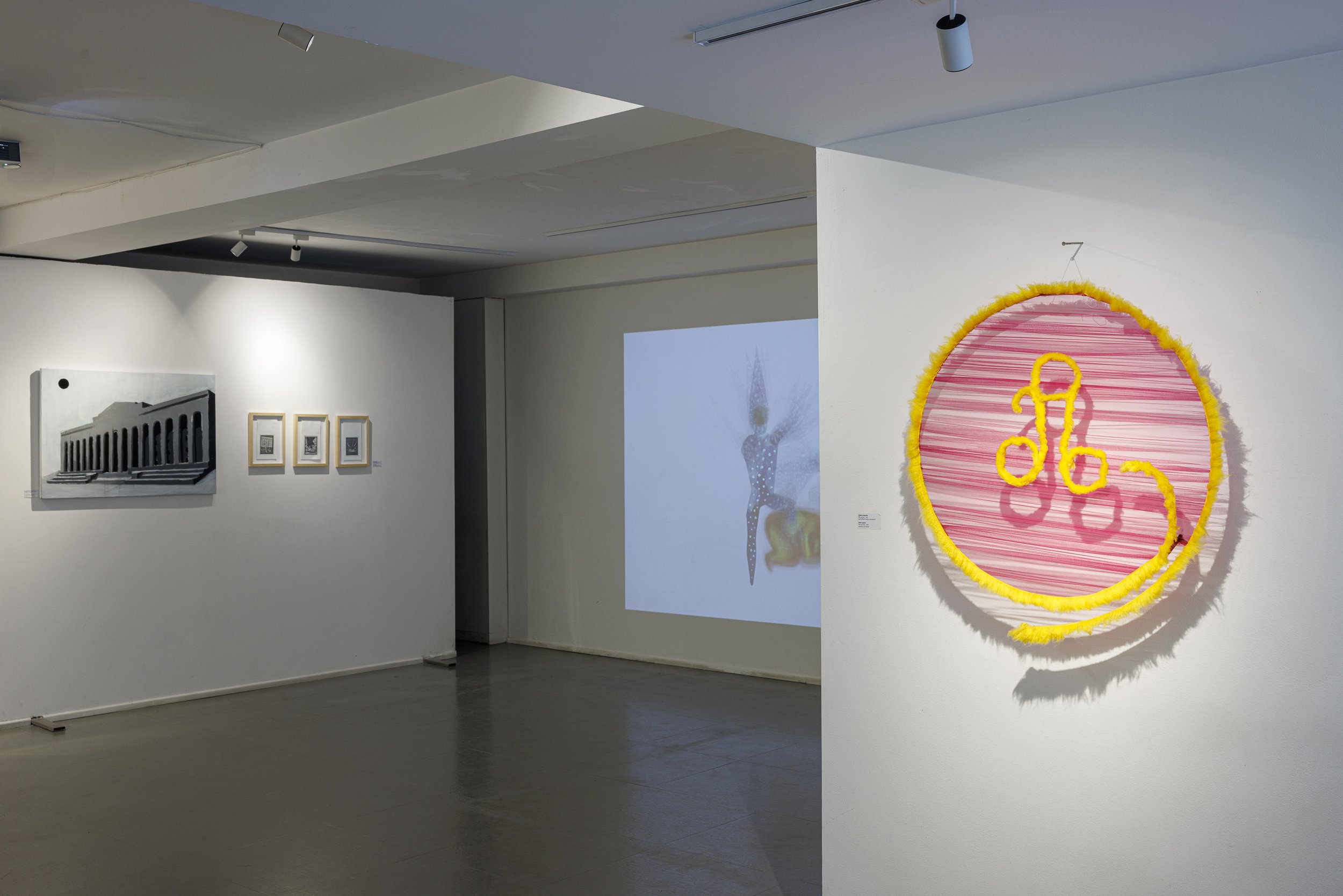SOS
February 9 - March 20, 2025
Artists: Tato Akhalkatsishvili, Nino Alavidze, Alexander (Sandro) Antadze, Uta Bekaia, Andro Dadiani, Rusudan Khizanishvili, Vakhtang Kokiashvili, Dato Koridze, Tamara K.E., Mia Okruashvili, Koka Ramishvili, Ani Toidze, Oto Tsagareishvili, Guram Tsibakhashvili
Window Project presents SOS, a group exhibition featuring Georgian contemporary artists from various generations. The exhibition reflects on contemporary politics and culture from 1989 to the present.
The exhibition’s title, SOS, is inspired by Koka Ramishvili’s military textile artwork. Between 1989 and 1992, Ramishvili created a significant body of work using military textiles, which engaged critically with the turbulent political climate and the state of war in Georgia. Blending elements of both painting and sculpture, the textiles were often torn or cut, while the stretcher bars were intentionally deformed. These artistic choices served as powerful vehicles for socio-political commentary, with imprinted words on the fabric symbolizing the crises of the era. In SOS, the distress signal—SO[S]—is incomplete, with its final symbol missing, preventing it from initiating a response. Through this form, Ramishvili references Georgia’s isolation in the 1990s, a period marked by the struggle for survival. The 2025 exhibition of SOS in Tbilisi serves as a warning, stressing the importance of ensuring that Georgia never again falls into isolation where its voice remains unheard.
Since 1989, despite or in response to wars, Russian occupation, and attempts to seize power and public space, Georgian contemporary art has challenged and reflected essential themes such as the need to critically rethink the past and present, demythologize history, emphasize individual responsibility in shaping public space, respect human rights and freedoms, and address identity crises and resilience in a politically unstable environment. Each work in the exhibition tells its own story and reflects the collective or individual perspectives of different eras. Regardless of artistic forms or time frames, visual analysis of collective states reveals the same processes: the struggle for political power in Georgia, the search for freedom, and the fight for independence, perceived as constant and inevitable.
The exhibition features The Lost Face (2024), a photograph by Nino Alavidze, which both literally and metaphorically symbolizes the dissolution of an individual’s identity when reduced to an unquestioning instrument of an authoritarian machine. The image reflects the erosion of personal autonomy and selfhood, emphasizing how integration into an oppressive system leads to the loss of individuality. OSCE/ODIHR Report (2025), a painting by Alexander (Sandro) Antadze, depicts the Georgian Parliament building in shades of grey, reflecting on the OSCE/ODIHR report regarding the parliamentary elections held in Georgia on October 26, 2024. The report, subject to varying political interpretations, had already lost relevance by the time of publication, primarily due to violations of the Georgian Constitution and violence enacted against demonstrators. The graphic series Baby Gargantua (2024) by Tato Akhalkatsishvili metaphorically represents psychological states of power and hedonism. Baby Gargantua references the satirical pentalogy by the 16th-century French author François Rabelais, which narrates the story of two giants, Gargantua and his son Pantagruel, through a satirical lens. In Akhalkatsishvili’s painting The Big Party (2025), inspired by 1960s poster aesthetics, the Christmas tree is depicted within a context of physiological elements. As a symbol of life and renewal, the tree is subjected to various forms of violence, including burning, toppling, isolation, or being used as a psychological tool. Akhalkatsishvili began incorporating the Christmas tree as a significant symbol in his work in 2016, and it has since become a central motif in his thematic series. Uta Bekaia’s animated video work My Sweet Little Rabbit (2022) critically examines the cyclical nature of violence, both globally and within Georgia, where it has been internalized and normalized. The work critiques this acceptance of violence, exploring how it has become embedded in the social fabric, ensuring its persistent presence. As part of a broader multimedia series, Bekaia uses the figure of the bunny as an avatar, transforming it into a symbol of self-representation. This avatar not only reflects the artist’s personal experiences but also embodies the vulnerability faced by LGBT+ individuals in Georgia, conveying both individual and collective struggles, while highlighting the emotional challenges faced by marginalized communities in the country. The Sun Disk (2020) by Andro Dadiani is inspired by the artist’s personal experiences with the oppression, mockery, and exclusion faced by queer-identifying individuals in Georgia. Dadiani transforms and "heals" these negative childhood experiences using light materials and vibrant colors. The graphical diptych Gagra (2024) by Ani Toidze is a tribute to the occupied Georgian city of Gagra, presenting an imagined version of the city with charred palm trees and girls swinging in opposing directions. This dreamlike composition intensifies the feeling of melancholy and reflects on the sociopolitical reality of the city’s occupation. In her series Remnants of the Glaring Day (2024), Tamara K.E. addresses cultural memories, creating free-flowing systems of codes, signifiers, and energy fields, culminating in a final outcry of farewell to history. Rooted in personal turmoil, La Chute du Régime (2024-2025), a metal engraving triptych by Mia Okruashvili, attempts to bring together elements of the collective struggle we face today. Flags, fireworks, and burnt trash cans have all become symbols of defiance and hope for change. Combining etching, drypoint, and aquatint techniques, these engravings emerged from feelings of helplessness and rage while witnessing the struggle from afar. Each line etched into the metal echoes with this distance and longing. Koka Ramishvili’s The Double of Georgia (Doppelgänger)(2024-2025), created amidst the ongoing political crisis, depicts a black-and-white version of the modern Georgian flag, shown in both positive and negative contrasts. The work embodies Georgia’s duality, illustrating the country’s polarization and highlighting the tensions between the state and society. Through this artwork, Ramishvili revisits a theme he first explored in 1991 with Inverted Masterpiece, which used the Georgian flag of that era. The piece featured a flag made from fabric in the opposite colors of the Georgian flag, accompanied by a tennis racket without strings. The work critiqued the state and its institutions, suggesting that, despite Georgia’s independence, both in substance and function, it contradicted the true representation of a state. The video work Noise (2024) by Dato Koridze, created in November 2024, documents ongoing protests in Tbilisi. Noise captures demonstrators striking their hands and objects against the iron barricade placed in front of the Georgian Parliament. Symbolically, the work reflects both the physical and metaphorical divide between the state and its citizens, emphasizing the alienation fostered by the authorities. The barricade becomes a symbol of this separation, where the voices of the people are reduced to mere noise, either unheard or disregarded by those in power within the walls of Parliament. Vakhtang Kokiashvili’s pop-art installations The Goat and Gigo (1994-2010), The Golden Tree of Democracy (2003), and The Grave of a Vandal (1994-2010), created between 1994 and 2010, address social and political events in both Soviet and independent Georgia. The series features commercial effects, kitsch, trash, religious and political narratives, and mythological forms, all translated into contemporary communication forms. Tbilisi Loves You (2020-2025), a painting by Oto Tsagareishvili, began in 2020, just before he left Georgia to start his bachelor’s degree. Initially a simple depiction of his house, the work was revisited and completed after his return to Tbilisi in 2024. Over time, the work evolved to reflect the rhythms of daily life in Georgia and the shifting political landscape in Tbilisi, capturing a period marked by transition, homecoming, and unrest. Another painting by Tsagareishvili, Untitled (Party) (2023), portrays a late-stage house party at his apartment, with four close friends and a self-portrait in the mirror. It serves as a precursor to Looking for Fun, marking the beginning of a series focused on leisure. Guram Tsibakhashvili’s photographic series (1989, 1990, 1993) serves as a historical record of Georgia’s social and political climate during a critical moment in its history. The 9th April 1989 demonstration, a significant event in Georgia’s fight for independence from the Soviet Union, is captured within the broader context of the societal and political challenges during Georgia’s pursuit of sovereignty. Through this work, Tsibakhashvili offers a visual account of Georgia’s social and political landscape during this pivotal period. Rusudan Khizanishvili reinterprets personal experiences, the lives of historical heroes, and the fates of mythological characters, creating a new personal mythology always influenced by the artist’s current context. In Khizanishvili’s work, the central figure is consistently a woman or a creature embodying feminine strength. The artwork Divine Flame, created last year in the context of ongoing political tensions, serves as a reflection of both the artist’s personal physical and emotional state, as well as the collective trauma of society.
-

Exhibition View
Koka Ramishvili
-

Exhibition View
Koka Ramishvili
-

Exhibition View
Dato Koridze
-

Exhibition View
Tato Akhalkatsishvili
-

Exhibition View
Tato Akhalkatsishvili
-

Exhibition View
Vakhtang Kokiashvili, Oto Tsagareishvili
-

Exhibition View
Nino Alavidze, Tamara K.E., Vakhtang Kokiashvili, Oto Tsagareishvili
-

Exhibition View
Nino Alavidze, Tamara K.E.
-

Exhibition View
Oto Tsagareishvili, Guram Tsibakhashvili, Alexander (Sanndro) Antadze
-

Exhibition View
Guram Tsibakhashvili
-

Exhibition View
Alexander (Sandro) Antadze, Mia Okruashvili
-

Exhibition View
Uta Bekaia
-

Exhibition View
Rusudan Khizanishvili, Ani Toidze
-

Exhibition View
Alexander Anntadze, Mia Okruashvili, Uta Bekaia, Andro Dadiani
